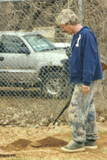Following Thanksgiving the first freeze arrived and the remaining leaves broke from their parents to rain, collecting in crisp piles on the lawn. The trees provide a charming parting gift if one swishes and crunches through the woods, enjoying the marvelous feel of fall. The sun has assumed a warm luster, making one forget racing from shade to shade to evade it at the height of summer. And the stark sculptural beauty of the barren trees provide yet another visual interest by allowing us to see the antics of the birds darting in and among the branches.
Since the birds are no longer hidden and muffled by a bevy of leaves, their aeronautic antics become clearly visible. Now is time to fill the feeders and enjoy their seasonal mirth from the warmth of the living room! We are fortunate to have many birds who choose come to the neighborhood to make their home for the winter. The Blue Jays, Titmouse and Chickadee, Sparrows, Mockingbird, Goldfinch, and adorable Cardinals all appear at scheduled eating times. The personalities of each species is apparent to observation, with the most respected amongst the crowd being the Red Headed Woodpecker. Perhaps it is his daunting beak, or the fact he may cling to an edge with his funny feet. Regardless, upon his arrival there is mass panic and every bird disappears in a rush of wings except the daring Titmouse who will dart in to snatch a sunflower seed without stopping to rest.
To seriously feed the birds, it is unnecessary to assume financial ruin. A standard mix of wild bird feed is easily affordable and will instantly draw birds to your feeder. They tend to eat at specific times so often there will be dozens at the feeder, and often not a single guest. It is as though they have breakfast, lunch and dinner at appointed hours.
One year we had a (large) unusual Blue Grosbeak arrive. Never before seen in the neighborhood, we were wildly excited, dragging out the bird book to identify and then provide proper food for him. Our ornithologist neighbor came to photograph him and record the unusual event in her journal. The next day there were two; we were thrilled! The following four… by the fifth day there were at least two hundred! Our more polite guests were shoved from the feeder as the raucous crowd bullied and shoved, jumping up and down, screeching and pushing, making our feeder the equivalent of an on-going bar room brawl! We panicked, recalling the Alfred Hitchcock thriller ‘The Birds’ and removed their favorite food; in fact we removed all food. Each morning we cautiously opened the curtains to see if they had abandoned our world and moved along. Happily, by the second week they suddenly disappeared and things got back to normal… with our usual guests a bit frazzled but grateful for peace and casual dining.

Blue Grosbeaks aside, a high quality bird feeder and an assortment of feed would make a thoughtful Christmas gift for anyone.


